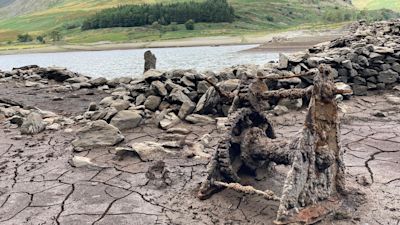'Lost' village reappears as reservoir supplying parts of the North West sees drop in water levels

Ralph Blumson reports from Haweswater Reservoir.
There are concerns about water levels in the Lake District reservoir which supplies large parts of the North West.
The levels have fallen so low in Haweswater that the remains of a 'lost' village, usually submerged, is one again visible.
Mardale was flooded to make way for the reservoir, near Penrith, in the 1930s, which was built to supply water to Manchester.
But since more people are working from home during the pandemic, and the lack of rain in recent months, it has led to parts of the settlement re-emerging.
United Utilities say we are not at crisis-point just yet, but heavy rainfall and careful use of water in homes is needed.
Where is Mardale and why was it flooded?
In the 1920s, demand for water increased and companies began looking for areas in which they could introduce reservoirs.
Despite a public outcry, Mardale was selected in 1935 by United Utilities, then called the Manchester Corporation, to be transformed into Haweswater reservoir.
As the water levels fall the valley gradually reveals its past. It's thought there were twelve houses in the hamlet, as well as a church and an Inn called the Dun Bull.
The community is said to have been strong and close knit and mainly occupied by farmers.
A spokesperson from United Utilities as asking customers to use their water wisely.
He said: “Reservoirs always tend to be at their lowest at the end of summer ahead of the winter refill, however, some of our reservoirs are lower than we would expect at this time of year."
The company is urging people to make 'simple changes' like only running the washing machine with a full load and turning the tap off when brushing teeth.